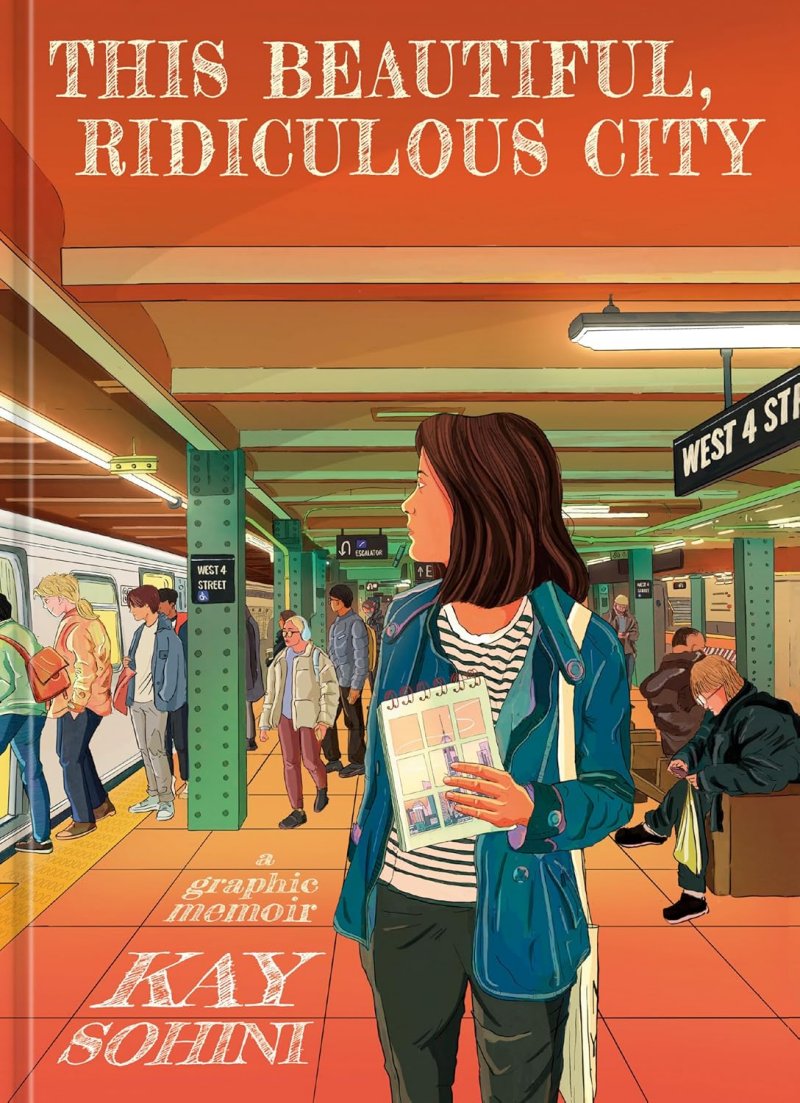 A Calcutta transplant’s love song to New York City.
A Calcutta transplant’s love song to New York City.
Creative Staff:
Story: Kay Sohini
Art: Kay Sohini
What They Say
On her first night in New York City, Kay Sohini sits on the tarmac of JFK Airport making an inventory of everything she’s left behind in India: her family, friends, home, and gaslighting ex-boyfriend. In the wake of that untethering she realizes two things: she’s finally made it to the city of her literary heroes—Kerouac, Plath, Bechdel—and the trauma she’s endured has created gaping holes in her memory.
As Kay begins the work of piecing herself back together she discovers the deep sense of belonging that can only be found on the streets of New York City. In the process she falls beautifully, ridiculously in love with the bustling landscape, and realizes that the places we love do not always love us back but can still somehow save us in weird, unexpected ways.
At once heartbreaking and uplifting, This Beautiful, Ridiculous City explores the relationship between trauma and truth, displacement and belonging, and what it means to forge a life of one’s own.
Content: (please note that content portions of a review may contain spoilers):
Kay Sohini has always daydreamed about New York City from her middle-class Calcutta suburb. At the age of 24, she finally makes the leap to New York. Partly pursue a PhD in English, partly to put an abusive relationship behind her. And amidst the city’s chaotic bustle, she finds healing and a place to belong.
This Beautiful, Ridiculous City is subtitled A Graphic Memoir, so the narrative is in first person. There’s no dialogue or scenes, just a lot of prose with sentences that tend to get overly long. The text is formatted into blocks that are arranged into accompanying illustrations, most of which take up a full page or two pages. The art style varies depending on the theme, but for the most part, illustrations are richly colored and digitally rendered. At certain points, photographs are inserted amid the drawings. The quality of the paper, binding, and printing are all top-notch.
Visually, the book is gorgeous, but in terms of written content, it’s all over the place. The contents consist of six chapters. “Chapter 1: New York before New York” is essentially Sohini fangirling over literature, specifically New York literature. “Chapter 2: The Nineties, the New Millennium, and a Postcolonial Nation” describes the cultural, social, and economic backdrop against which she grew up, which is helpful for those unfamiliar with India. In “Chapter 3: Clementines, Because in Bengali, We Do Not Say, ‘I Love You’,” she describes at length the various foods her family ate before concluding with an abrupt account of her grandfather’s death. “Chapter 4: A Death and a Disappearing Act” explores her dysfunctional relationship with her abusive ex-boyfriend. “Chapter 5: New York, New York” is Sohini fangirling over the city’s energy, architecture, landmarks, and diverse foods. “Chapter 6: A Room of One’s Own in This Beautiful, Ridiculous City” is a commentary about housing and the challenges to home ownership in New York.
As a life narrative, the book comes across as guarded and disconnected. Sohini is enthusiastic about sharing the details of the books she loves in Chapter 1, the foods she loves in Chapter 3, and the city she loves in Chapter 5. She is much less generous about relationships with family and friends. Beyond a description of the dishes her grandmother made to spoil her, we don’t get any sense of how Sohini interacted with relatives. It’s not until Chapter 6 that she mentions she grew up in a four generation household of 14. Also, the narrative might lead you to think she’s an only child, except for a single offhanded mention of an estranged sibling midway through the book, and she doesn’t even bother mentioning the sibling’s gender. She talks more about the Indian superstar Shah Rukh Khan than she does about the husband she met and married in New York. As such, when she mentions the huge personal impact of grandfather’s death at the end of Chapter 3, it seems to come out of nowhere.
Her personal journey from brokenness to healing also comes across as unbalanced. She goes into extreme depth about how her manipulative boyfriend destroyed her sense of self in Chapter 4, but she spends scant time sharing how she healed from it. Despite her refrain about arriving in America with holes in her memory, once in New York, the narrative’s all about how awesome the city is rather than the process of filling those memory holes.
As such, the book comes across more like social commentary and essays with bits of Sohini’s personal experiences woven in. If you love all things New York City, you’ll probably enjoy her gushing. However, keep in mind that the book contains as much content about India as New York.
By the way, Sohini supports her commentaries with quotes and periodical headlines, but her one chart in the section about disparity in home ownership makes no mathematical sense. The bar chart shows “Percentage of Statewide Owner-Occupied Units” by race. If you add the percentages for Asian, Black, Latino, and White, you get 175%. If you include Other, the total goes up to 200%.
In Summary:
The illustrations are vibrant, but the writing not so much. The book is supposed to be a memoir, but Sohini is stingy with the details of her life. As such, it ends up being more social commentary and a laundry list of what she loves about New York City rather than a record of a unique life lived.
Art: A-
Content: C+
Age Rating: 13+
Released By: Ten Speed Graphic
Release Date: January 28th, 2025
MSRP: $24.95




